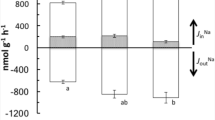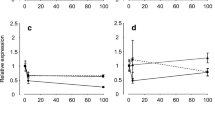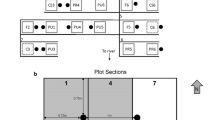Abstract
Transepithelial potentials (TEP) were measured in killifish, acclimated to freshwater (FW), seawater (SW), 33% SW or cycling salinities relevant to tidal cycles in an estuary, and subsequently subjected to salinity changes in progressive or random order. Random compared to progressive salinity changes in an upward or downward direction in FW- and SW-acclimated fish, respectively, did not greatly influence responses to salinity change. Fish acclimated to SW or 33% SW as well as those acclimated to cycling salinities behaved similarly (TEP more positive than +15 mV in 100% SW, decreasing to ~0 mV at 20–40% SW, and more negative than −30 mV in FW). In contrast, FW-acclimated fish displayed a less pronounced TEP response to salinity (0 mV in FW through 20% SW, increasing thereafter to values more positive than +10 mV at 100% SW). We conclude that when evaluated under estuarine tidal conditions, the killifish gill exhibits adaptive electrical characteristics, opposing Na+ loss at low salinity and favouring Na+ extrusion at high salinity, changes explained at least in part by the Cl− to Na+ permeability ratio. Thus animals living in the estuaries can move to lower and higher salinities for short periods with little physiological disturbance, but this ability is lost after acclimation to FW.




Similar content being viewed by others

References
Abraham BJ (1985) Species profiles: life histories and environmental requirements of coastal fishes and invertebrates (Mid-Atlantic)—mummichog and striped killifish. US Fish Wild Serv Biol Rep 82(11.40). US Army Corps of Engineers, TR EL-82-4, pp 23
Copeland DE (1950) Adaptive behaviour of the chloride cell in the gill of Fundulus heteroclitus. J Morphol 87:369–379
Daborn K, Cozzi RRF, Marshall WS (2001) Dynamics of pavement cell-chloride cell interactions during abrupt salinity change in Fundulus heteroclitus. J Exp Biol 204:1889–1899
Degnan KJ, Zadunaisky JA (1980) Passive sodium movement across the opercular epithelium: the paracellular shunt pathway and ionic conductance. J Membr Biol 55:175–185
Eddy FB (1975) The effect of calcium on gill potentials and on sodium and chloride fluxes in the goldfish, Carassius auratus. J Comp Physiol 96:131–142
Fritz ES, Garside ET (1974) Salinity preferences of Fundulus heteroclitus and F. diaphanus (Pisces: Cyprinodontidae): their role in geographic distribution. Can J Zool 52:997–1003
Goldman DE (1943) Potential, impedance, and rectification in membranes. J Gen Physiol 27:37–60
Griffith RW (1974) Environment and salinity tolerance in the genus Fundulus. Copeia 1974:319–331
Grosell M, Hogstrand C, Wood CM, Hansen JM (2000) A nose-to-nose comparison of the physiological effects of exposure to ionic silver versus silver chloride in the European eel (Anguilla anguilla) and the rainbow trout (Oncorhynchus mykiss). Aquat Toxicol 48:327–343
Hossler FE, Musil G, Karnaky KJ, Epstein FH (1985) Surface ultrastructure of the gill arch of the killifish, Fundulus heteroclitus, from seawater and freshwater, with special reference to the morphology of apical crypts of chloride cells. J Morphol 185:377–386
House CR, Maetz J (1974) On the electrical gradient across the gill of the seawater adapted eel. Comp Biochem Physiol 47A:917–924
Jacob WF, Taylor MH (1983) The time course of seawater acclimation in Fundulus heteroclitus L. J Exp Zool 228:33–39
Karnaky KJ Jr (1986) Structure and function of the chloride cell of Fundulus heteroclitus and other teleosts. Am Zool 26:209–224
Karnaky KJ (1991) Teleost osmoregulation: changes in the tight junction in response to the salinity of the environment. In: Cereijido M (ed) Tight junctions. CRC Press, Boca Raton, pp 175–185
Katoh F, Hasegawa S, Kita J, Takagi Y, Kaneko T (2001) Distinct seawater and freshwater types of chloride cells in killifish, Fundulus heteroclitus. Can J Zool 79:822–829
Katoh F, Kaneko T (2003) Short-term transformation and long-term replacement of branchial chloride cells in killifish transferred from seawater to freshwater, revealed by morphofunctional observations and a newly established ‘time-differential double fluorescent staining’ technique. J Exp Biol 206:4113–4123
Katoh F, Hyodo S, Kaneko T (2003) Vacuolar-type proton pump in the basolateral plasma membrane energizes ion uptake in branchial mitochondria-rich cells of killifish Fundulus heteroclitus, adapted to a low ion environment. J Exp Biol 206:793–803
Kirsch R (1972) The kinetics of peripheral exchanges of water and electrolytes in the silver eel (Anguilla anguilla L.) in fresh water and sea water. J Exp Biol 57:489–512
Kneib RT (1986) The role of Fundulus heteroclitus in salt marsh trophic dynamics. Am Zool 26:259–269
Lacy ER (1983) Histochemical and biochemical studies of carbonic anhydrase activity in the opercular epithelium of the euryhaline teleost Fundulus heteroclitus. Am J Anat 166:19–39
Laurent P, Chevalier C, Wood CM (2006) Appearance of cuboidal cells in relation to salinity in the gills of Fundulus heteroclitus, a species exhibiting branchial Na+ but not Cl− uptake in freshwater. Cell and Tissue Res 325:481–492
Marshall WS (2003) Rapid regulation of NaCl secretion by estuarine teleost fish: coping strategies for short-duration freshwater exposures. Biochim Biophys Acta 1618:95–105
Marshall WS, Bryson SE, Darling P, Whitten C, Patrick M, Wilkie M, Wood CM, Buckland Nicks J (1997) NaCl transport and ultrastructure of opercular epithelium from a freshwater-adapted euryhaline teleost, Fundulus heteroclitus. J Exp Zool 277:23–37
Marshall WS, Bryson SE (1998) Transport mechanisms of seawater teleost chloride cells: an inclusive model of a multifunctional cell. Comp Biochem Physiol A119:97–106
Marshall WS, Emberley TR, Singer TD, Bryson SE, McCormick SD (1999) Time course of salinity adaptation in a strongly euryhaline estuarine teleost, Fundulus heteroclitus: a multivariable approach. J Exp Biol 202:1535–1544
Patrick ML, Pärt P, Marshall WS, Wood CM (1997) Characterization of ion and acid-base transport in the fresh-water adapted mummichog (Fundulus heteroclitus). J Exp Zool 279:208–219
Patrick ML, Wood CM (1999) Ion and acid-base regulation in the freshwater mummichog (Fundulus heteroclitus): a departure from the standard model for freshwater teleosts. Comp Biochem Physiol 122A:445–456
Philpott CW, Copeland DE (1963) Fine structure of chloride cells from three species of Fundulus. J Cell Biol 18:389–404
Pic P (1978) A comparative study of the mechanisms of Na+ and Cl− excretion by the gill of Mugil capito and Fundulus heteroclitus: effects of stress. J Comp Physiol 123:155–162
Potts WTW (1984) Transepithelial potentials in fish gills. In: Hoar WS, Randall DJ (eds) Fish physiology, vol 10B. Academic Press, Orlando, pp 105–128
Potts WTW, Eddy FB (1973) Gill potentials and sodium fluxes in the flounder Platichthys stellatus. J Comp Physiol 87:20–48
Potts WTW, Hedges AJ (1991) Gill potentials in marine teleosts. J Comp Physiol B161:401–405
Potts WTW, Fletcher CR, Hedges AJ (1991) The in vivo transepithelial potential in a marine teleost. J Comp Physiol B161:393–400
Prodocimo V, Galvez F, Freire CA, Wood CM (2007) Unidirectional Na+ and Ca2+ fluxes in two euryhaline teleost fishes, Fundulus heteroclitus and Oncorhynchus mykiss, acutely submitted to a progressive salinity increase. J Comp Physiol B177:519–528
Scott GR, Baker DW, Schulte PM, Wood CM (2008) Physiological and molecular mechanisms of osmoregulatory plasticity in killifish after seawater transfer. J Exp Biol 211:2450–2459
Scott GR, Rogers JT, Richards JG, Wood CM, Schulte PM (2004) Intraspecific divergence of ionoregulatory physiology in the euryhaline teleost Fundulus heteroclitus: possible mechanisms of freshwater adaptation. J Exp Biol 207:3399–3410
Scott GR, Schulte PM, Wood CM (2006) Plasticity of osmoregulatory function in the killifish intestine: drinking rates, salt and water transport, and gene expression after freshwater transfer. J Exp Biol 209:4040–4050
Silva P, Solomon R, Spokes K, Epstein FH (1977) Ouabain inhibition of gill Na+-K+-ATPase: relationship to active chloride transport. J Exp Zool 199:419–426
Sten-Knudsen O (2002) Biological membranes: theory of transport, potentials, and electrical impulses. Cambridge University Press, Cambridge
Taylor JR, Whittamore JM, Wilson RW, Grosell M (2007) Post-prandial acid-base balance and ion regulation in freshwater and seawater-acclimated European flounder, Platichthys flesus. J Comp Physiol B177:597–608
Tomasso JR Jr, Grosell M (2005) Physiological basis for large differences in resistance to nitrite among freshwater and freshwater-acclimated euryhaline fishes. Environ Sci Technol 39:98–102
Wood CM, Grosell M (2008) A critical analysis of transepithelial potential in intact killifish (Fundulus heteroclitus) subjected to acute and chronic changes in salinity. J Comp Physiol B178:713–727
Wood CM, Laurent P (2003) Na+ versus Cl− transport in the intact killifish after rapid salinity transfer. Biochim Biophys Acta 1618:106–119
Wood CM, Marshall WS (1994) Ion balance, acid-base regulation, and chloride cell function in the common killifish, Fundulus heteroclitus—a euryhaline estuarine teleost. Estuaries 17:34–52
Zadunaisky JA (1984) The chloride cell: the active transport of chloride and the paracellular pathways. In: Hoar WS, Randall DJ (eds) Fish physiology, vol 10B. Academic Press, Orlando, pp 130–176
Zadunaisky JA, Cardona S, Au L, Roberts DM, Fisher E, Lowenstein B, Cragoe EJ, Spring KR (1995) Chloride transport activation by plasma osmolarity during rapid adaptation to high salinity of Fundulus heteroclitus. J Membr Biol 143:207–217
Acknowledgments
We thank Sue Ebanks and Bob Gerdes for excellent maintenance of the aquatic system, and two anonymous reviewers whose constructive comments improved the MS. The experiments complied with the current laws of the United States and Canada. The research was supported by NSF grants (0416440, 0714024 and 0743903) to MG and an NSERC Discovery Grant to CMW. CMW is supported by the Canada Research Chair Program.
Author information
Authors and Affiliations
Corresponding author
Additional information
Communicated by G. Heldmaier.
Rights and permissions
About this article
Cite this article
Wood, C.M., Grosell, M. TEP on the tide in killifish (Fundulus heteroclitus): effects of progressively changing salinity and prior acclimation to intermediate or cycling salinity. J Comp Physiol B 179, 459–467 (2009). https://doi.org/10.1007/s00360-008-0323-3
Received:
Revised:
Accepted:
Published:
Issue Date:
DOI: https://doi.org/10.1007/s00360-008-0323-3



